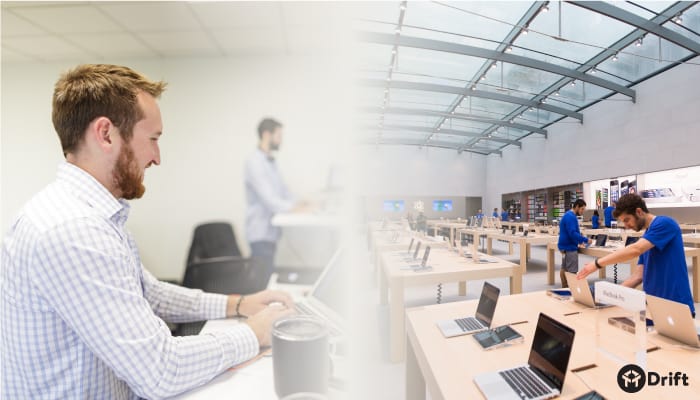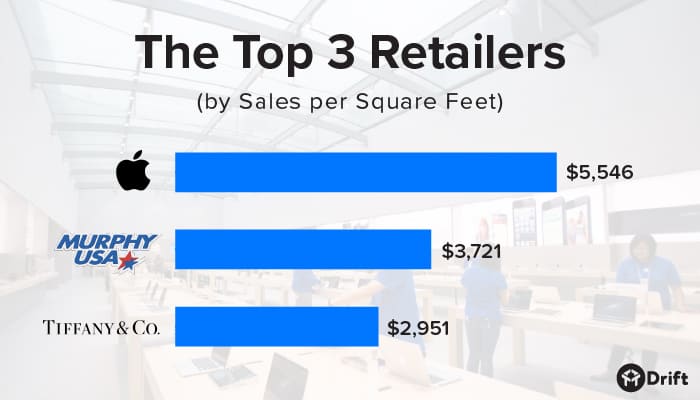
Have you ever walked into an Apple Store and asked someone a question, and they said to you, “I don’t know, that’s not my job,” and walked away?
I bet that’s never happened to you. (It’s never happened to me.)
But guess what?
With every SaaS business we deal with everyday, that happens to us. That gets inflicted on us:
“It’s not my job. I have no idea. Talk to support. Talk to sales. Talk to the engineers.”
That’s the terrible experience we’re trying to save the world from at Drift. And we’re looking to Apple — and specifically, the retail experience customers get at the Apple Store — to figure out what the future should look like.
We didn’t think about their experience in the store. We said, let’s design this store around their life experience. We said there’s a bigger idea. Let’s design it around the customer’s life, not the moment when they’re in the store. We said, we want our stores to create an ownership experience for the customer. That’s what we try to create. We like to think that’s where it begins.
— Ron Johnson, Apple’s former SVP of retail operations
Why Apple Is Our SaaS Role Model
I’ve been thinking a lot lately about how we build the company of the future here at Drift.
And I always come back to these three key ingredients:
- We need to have the best products.
- We need to have the best service.
- We need to have the best brand.
Those are the three moats that we want to build around our company.
But what does the model for that look like? Whose example do we follow?
In the entire world, only one company comes to mind. And that company is Apple.
So we look at Apple, a company that has the best-designed products in the world, and that’s created a monopoly with the products that they sell. You could say that their products sell themselves.
Apple also has one of the most recognized and most valuable brands in the world (worth $170 billion). And of course we’re all familiar with their iconic advertising work.
And yet, in their retail stores, Apple spends an insane amount of energy, time, and focus on creating a magical experience.
Remember: This is a company with the world’s best products and the world’s most valuable brand. They don’t need to go the extra mile in order to be successful here, but they still do. We all need to be following that example when it comes to customer experience. (And considering we don’t have a monopoly with our products or the world’s most valuable brand, we should be trying even harder.)
Apple creates such an incredible buying experience for its customers that the Apple Store is the world’s No. 1 retailer — selling $5,546 per square foot of retail space.

But how exactly has the Apple Store managed to become so extraordinarily successful?
And more importantly, how can we apply that same model to SaaS and B2B sales so we can fix the terrible experience buyers have been getting?
How to Create the Apple Store Experience for SaaS Sales
1. Say hello to potential customers when they land on your website.
When you walk into an Apple Store, you feel the magic right way because there’s always someone waiting there to greet you.
It might seem like a small gesture, but imagine if you walked into a store and everyone working there ignored you. Imagine if no one would answer your questions in real-time.
That’s exactly how buyers feel when they land on most B2B websites today. Instead of a warm “Hello,” they’re greeted with a cold, static lead form. And instead of a real-time conversation, they’re forced to wait for a follow-up.
You’d never get that type of experience in an Apple Store. And this is a company that has a monopoly on their market, and that has the most valuable brand in the world — they still make sure they’re doing the little things like greeting customers as they walk in.
So if anyone tells you that they can’t greet every customer on their website, that they don’t have enough time, that it doesn’t scale, that they don’t have the bandwidth to do that, point them to the Apple Store and tell them to take notes.
2. Don’t inflict your company org chart on leads and customers.
When you’re inside an Apple Store, how do you know who the salespeople are? Or who the support people are? Or who the trainers and educators are?
I bet you each time you walk in, you can’t distinguish between the different roles.
From a customer experience standpoint, there is no separation. Even though there might be people within the store who specialize in different things, we as the customer have no idea.
And that’s exactly the point. That’s the genius in what they do.
Because there shouldn’t be a difference to the customer. That’s a company problem: Who does sales, who does support. It shouldn’t be the customer’s problem to figure out who does what and who they should go talk to.
But with most B2B companies today, what you hear is “It’s not my job. You need to talk to support,” or, “You need to talk to sales,” or, “You need to talk to customer success,” or, “You need to talk to our engineers.” And they’re going to hand off people and try to segment and inflict the company hierarchy and the company org chart on the customer.
These companies are our anti-role models They have separation between sales engineers, salespeople, marketers, customer success, account managers, people who do onboarding, and so on — and you as a customer have to navigate it all on your own.
That’s not the type of experience we should be providing.
Here’s what we should be doing instead:
3. Provide a personal concierge service on your website.
Instead of being siloed according to specific departments, all Apple Store employees have the same overarching mission: Help customers.
That means they don’t just greet customers as they walk in, but they also answer all of their questions, and help guide them to certain areas of the store.
And if a customer question arises that an Apple Store employee can’t answer, no big deal: That employee will immediately go and get someone who can answer it.
At the Apple Store, it’s like you have a personal tour guide or concierge leading you through the buying process. And that’s exactly how buyers should feel on your website.
Instead of forcing buyers to figure everything out on their own, we should be guiding them through the buying process one-by-one. Instead of making them fill out forms and wait for follow-ups, we should be routing them automatically to people who can answer their questions in real-time.
Thanks to the rise of messaging and artificial intelligence, we can now deliver this Apple Store-inspired experience at scale.
Because even if all of the humans on your team are asleep, we now have chatbots that can respond to questions, ask qualifying questions of their own, and even schedule demos for sales reps around the clock.
That’s the type of one-to-one, on-demand experience today’s buyers have come to expect — not just in the Apple Store, but also on your website.
Final Thought: Focusing on What Buyers Want
With the Apple Store, Steve Jobs and Ron Johnson created a retail environment that was designed around the customer’s life and their experience. It wasn’t a space for pushing products on people, it was a space where buyers could come and explore and get their questions answered.
Apple succeeded because they focused on what we want as consumers, and I think that’s what the future of SaaS and B2B sales looks like: It looks like the Apple Store retail experience.
To help companies all around the world provide that level of experience, we’re building the world’s first conversational marketing and sales platform here at Drift.
Want to learn more?



